|
|
|
|
|
|
|
|
Visit India |
|
|
|
|
|
|
|
|
|
Kargil |
|
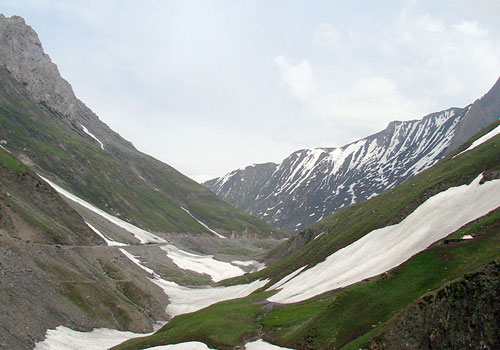 Kargil, the headquarter of Kargil district, is around 204 Kms. to the east of Srinagar and 234 Kms. to the west of Leh. It was a transit point of caravans on their way to and from China, Tibet, Yarken and Kashmir till 1949, but since 1974 with the influx of tourists the region has been replaced as centre for tourism related activities. Kargil, the headquarter of Kargil district, is around 204 Kms. to the east of Srinagar and 234 Kms. to the west of Leh. It was a transit point of caravans on their way to and from China, Tibet, Yarken and Kashmir till 1949, but since 1974 with the influx of tourists the region has been replaced as centre for tourism related activities.
Tourists traveling between Zangskar, Leh and Srinagar have to make a night halt here, before starting for the second day of their journey. Kargil is located on the bank of the Suru River which flows at around 10,000 ft. high.
Here people were followers of Buddhist religion till the 14th century AD. Presently, Kargil is inhabited by Muslims of Shia sect.
|
|
|
Zanskar |
|
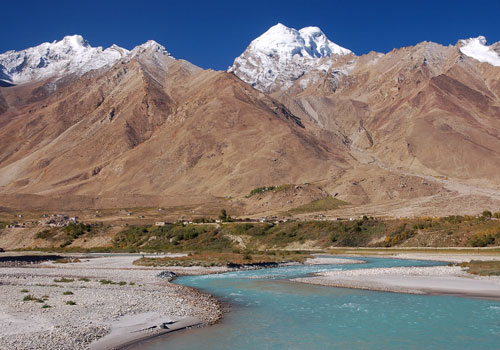 The remotest places on our planet often offer the most adventure and it is not different that the Zanskar Valley situated in one corner of India in the Western Himalayas offers its fair share too.
To reach Zanskar valley, one can take one of the many flights to Delhi and then from Delhi, you can either fly to Leh in Jammu and Kashmir’s Ladakh region or drive to Leh through the highest series of mountain passes in the world.
The Zanskar valley is a mecca for adventure travel enthusiasts. In summer, adventure lovers come here to raft on the ferocious Zanskar river where the rapids are typically Class 4 and Class 5.
The remotest places on our planet often offer the most adventure and it is not different that the Zanskar Valley situated in one corner of India in the Western Himalayas offers its fair share too.
To reach Zanskar valley, one can take one of the many flights to Delhi and then from Delhi, you can either fly to Leh in Jammu and Kashmir’s Ladakh region or drive to Leh through the highest series of mountain passes in the world.
The Zanskar valley is a mecca for adventure travel enthusiasts. In summer, adventure lovers come here to raft on the ferocious Zanskar river where the rapids are typically Class 4 and Class 5.
Rafting trips can be as short as 6 hours to as long as 7 days.
The river rafting expedition begins near Padum and ends just after the Sangam (the place where the Zanskar river joins the mighty Indus river). |
|
|
Drass |
|
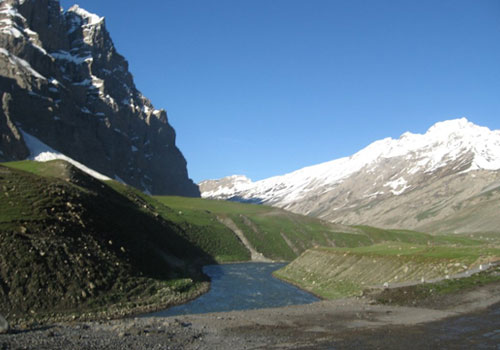 Drass (3230 m), 60 km west of Kargil on the road to Srinagar, is a small township lying in the centre of the valley of the same name. It has become famous as the second coldest inhabited place in the world by virtue of the intense cold that descends upon the valley along with repeated snowfalls during winters. Winter temperature is sometimes known to plummet to less than minus 40 degrees. Drass (3230 m), 60 km west of Kargil on the road to Srinagar, is a small township lying in the centre of the valley of the same name. It has become famous as the second coldest inhabited place in the world by virtue of the intense cold that descends upon the valley along with repeated snowfalls during winters. Winter temperature is sometimes known to plummet to less than minus 40 degrees.
The Drass valley starts from the base of the Zojila pass, the Himalayan gateway to Ladakh. For centuries its inhabitants are known to have negotiated this formidable pass even during the most risky period in the late autumn or early spring, when the whole sector remains snow-bound and is subject to frequent snow storms, to transport trader's merchandise across and to help stranded travellers to traverse it.
By virtue of their mastery over the pass they had established a monopoly over the carrying trade during the heydays of the Pan-Asian trade. A hardly people enduring with fortitude and harshness of the valley's winter, the inhabitants of drass can well be described as the guardian's of Ladakh's gateway. Drass is a convenient base for a 3-day long trek to Suru valley across the sub-range separating the two valleys.
This trek passes through some of the most beautiful upland villages and flower sprinkled meadows on both sides of the 4500 mts high Umbala pass, which falls enroute. The trek to the holy cave of Amarnath in neighboring Kashmir, which stars from Minamarg below Zojila, takes 3 days and involves crossing of 5200 mts high pass. Drass also offers numerous shorter treks and hikes to the upland villages. Note : All Tourists to Ladakh travelling from Srinagar by road are required to register themselves at the Tourist Registration Centre at Drass. |
|
| Nubra Valley |
|
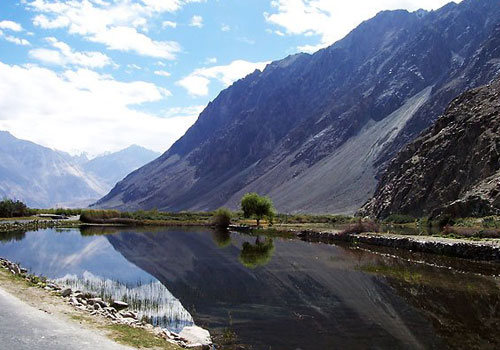 Nubra Valley Known as Ldumra (the valley of flowers) is situated in the north of Leh. The average altitude of the valley is about 10,000 ft. above the sea level. The main attraction in this area is the Bactarian Camels (Shaggy double hump Camel) around sand dunes, Deskit and Samstanling monasteries. Nubra Valley Known as Ldumra (the valley of flowers) is situated in the north of Leh. The average altitude of the valley is about 10,000 ft. above the sea level. The main attraction in this area is the Bactarian Camels (Shaggy double hump Camel) around sand dunes, Deskit and Samstanling monasteries.
The road journey to Nubra valley leads through the world highest motorable road, Khardongla Pass which is at a hight of 18380 ft above sea level and around 50 kms from Leh.
After crossing the pass, you can have a view of Khardong village, Khalser and Deskit (the main villages of Nubra valley). |
|
|
Leh |
|
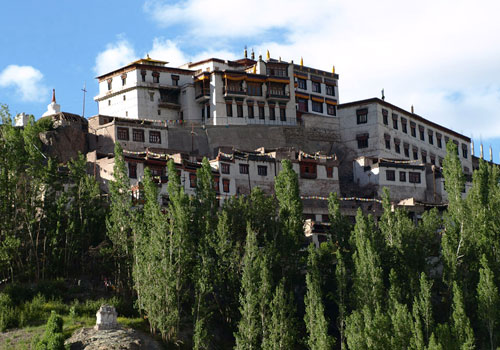 Leh, headquarter of Leh District is the largest town of the region. It is located to the north of the Indus River at an elevation of 3600m above the sea level. The town is dominated by the Namgyal Tsemo (victory peak) built by King Tashi Namgyal in 16th century, as a royal residence and the nine-storey Namgyal Palace built by King Sengge Namgyal on his victory in reunification of the Upper and Lower Ladakh in 17 century.
Leh, headquarter of Leh District is the largest town of the region. It is located to the north of the Indus River at an elevation of 3600m above the sea level. The town is dominated by the Namgyal Tsemo (victory peak) built by King Tashi Namgyal in 16th century, as a royal residence and the nine-storey Namgyal Palace built by King Sengge Namgyal on his victory in reunification of the Upper and Lower Ladakh in 17 century.
Leh became the capital of Stod (upper Ladakh) during the reign of King Graspa Bum- Lde, who ruled Ladakh from 1400 to 1430 AD. In the later period, Leh became an important center for trade in Central Asia, along the Indus Valley between Tibet to the east, Kashmir to the west and ultimately between India and China. Right below Leh Palace is the old mosque, a Sunni Muslim mosque. There is a religious coexistence of Buddhism and Islam, have been living in Harmony in Leh. Thus, Ladakh an ag-old tradition of cohesiveness Besides these two communities there are people living in the region who belongs to different religions like Christianity, Hinduism, and Sikhism.
|
|
|
Padum |
|
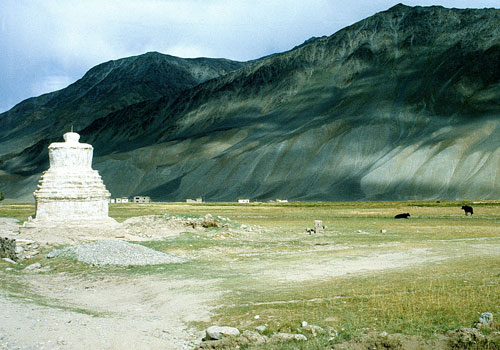 Once the capital of the ancient kingdom of Zanskar, Padum (3505 m) is the present day administrative headquarters of the region. With a population of nearly 1500, Padum can be described as the most populous settlement of Zanskar, otherwise a very scarcely inhabited valley.
Once the capital of the ancient kingdom of Zanskar, Padum (3505 m) is the present day administrative headquarters of the region. With a population of nearly 1500, Padum can be described as the most populous settlement of Zanskar, otherwise a very scarcely inhabited valley.
Incidentally, it is only in Padum that there is a community of Muslims constituting nearly half the township's population, its origin in the area dating from mid 17th century. Lately, Padum has become a famous as a major trekking base and a popular tourist destination.
Several places of tourist interest in the vicinity of the township can be visited in the course of entertaining walks. The nearest monument is a set of ancient rock carving on a huge boulder near the river bank, just below the old township.
These dates from the 8th century and provide epigraphic evidence that the region was under the influence of North Indian Buddhism since ancient times.
The Starrimo Monastery with about 30 resident monks clings to a tree-covered ridge above the old town. Across the expanse of cultivation lies the old village of Pibiting, dominated by its picturesque hilltop monastery, a superb manifestation of stupa architecture.
|
|
|
Dah Hanu |
|
 Dah HanuDah and Hanu are places on the far side of the great Indus River on the far side of Leh . Surrounded by the great Hindu - Kush mountains and peopled by a hardy but gentle people who have a bank of strange legends to relate for the weary traveller's ears. Living in almost sheer isolation, Dah and Hanu, the two villages can be accessed only by a really bumpy road ride, which skirts a sheer cliff face with the river flowing fast and furious below. Dah HanuDah and Hanu are places on the far side of the great Indus River on the far side of Leh . Surrounded by the great Hindu - Kush mountains and peopled by a hardy but gentle people who have a bank of strange legends to relate for the weary traveller's ears. Living in almost sheer isolation, Dah and Hanu, the two villages can be accessed only by a really bumpy road ride, which skirts a sheer cliff face with the river flowing fast and furious below.
Then one could trek up a goat-track and experience what it means to climb lofty mountains.
As one suddenly round a bend in the track, one is confronted with terraced fields of barley, studded with apricot trees, a smattering of stone huts and irrigation ditches covered with flagstones which are actually pathways. |
|
|
|
Scroll
|
|
|
|
 |
|
|
